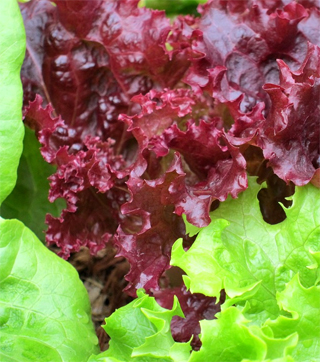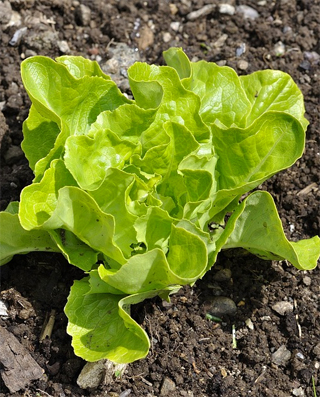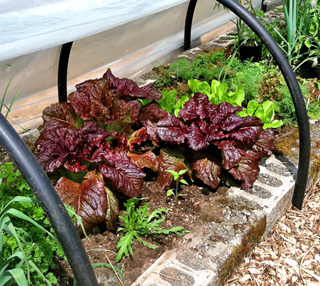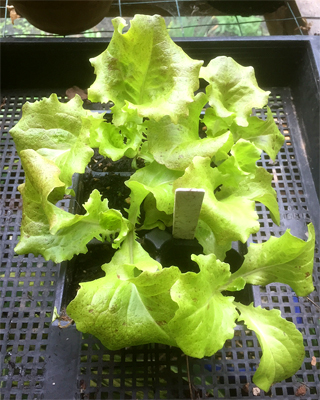
Delicious crisp lettuce (Lactuca sativa) with its huge variety of cultivars is the mainstay of fresh green salads and one of the most popular garden vegetables. Domestic lettuce is an Asian native related to wild lettuce (Latura scariola,) and belongs to the daisy family (Asteraceae.)
It is a hardy cool-season annual and will turn bitter and send up a seed stalk (called bolting) in hot weather. In the Pacific Northwest our long mild spring weather makes for ideal lettuce growing conditions. Our relatively mild winters also make it possible to harvest lettuce from a cold frame throughout the winter.
Varieties include butterhead with its round, smooth-leaved, open head and quick maturation; common or crisp-head (iceberg) which is much like butterhead but with a tighter head and crisper center; loose-leaf, with no distinct heart and longer indented leaves; and romaine or cos, an upright variety with a tight heart amidst oblong leaves.
Butterheads mature in as little as 34 days, crispheads around 60 days, loose-leaf and romaine types in 50-60 days.
Lettuce and Your Health
Lettuce is a low-cal way to get many of the necessary vitamins and minerals including a whopping 247% of daily vitamin A and a good dose of beta carotene, which converts to vitamin A in the body. It is also a good source of folate and Vitamin C, B-complex, and minerals including magnesium, iron, and potassium.
Loose-leaf varieties, like Romaine, contain the most high-protein chlorophyl and other phytonutrients. Red-leaved varieties of Romaine like Outredgeous or Marshall provide the most nutrients.
Seasonal Guide
Early Spring:
- For the earliest spring crop, start indoors 6 weeks before the last frost.
- Sow all types in cold frames in late February in the PNW.
Spring:
- Direct sow all varieties when soil can be worked using successive planting every 2-3 weeks.
- Harden off and set out transplants.
- Mulch between rows to keep soil cool.
Summer:
- Apply shade cloth or floating row cover to delay bolting.
- Harvest all types as needed for fresh use.
- Start a fall crop in flats in late summer.
Fall:
- Set out fall transplants.
- Cover with cloches or cold frames in late fall.
- Prepare next year’s spring beds by tilling in compost and planting a legume cover-crop.
Location
Deeply cultivated raised beds are an optimum choice for lettuce, but a well-drained, sunny, sheltered spot with good loam will work. Lettuce can also be under-planted and inter-planted in the garden: plant it in the shade under slow growers like leeks, celery, broccoli or cauliflower, among or edging flower beds, or in tubs or pots along with eggplant or tomatoes.
Soil Prep
Till in the cover-crop and work in quite a bit of well-rotted manure and compost if you didn’t do it in the fall. Add and incorporate lime to a depth of about 12”. Lettuce seed is small, so rake and sift the topsoil until it is fine and smooth. As with all small seed, we cover with potting soil instead of garden soil that has a tendency to produce a hard crust.
Planting
Sow in rows or blocks ¼” deep and fairly thickly. Cover lightly and press soil down gently. When two or three true leaves form, thin to 10”-12” for loose leaf types, 14”-16” for romaines, crisp-heads and butterheads. If planting in rows, leave 16”-18” between them.
Harden off transplants and set out at final spacing.
Apply a 10-10-10 fertilizer 2-3 times during the growing season. Weed shallowly, disturbing only the top inch or so of soil.
Water
Keep moist with a soaker hose and use mulch to retain moisture and keep soil cool.
Harvest
Pick individual leaves of loose-leaf and the outside of heads. Cut whole heads off at ground level with a sharp knife.
Pests and Diseases
In the Pacific Northwest, slugs are likely to be the most problematic pests for lettuce. Control them with bait traps or hand-picking. See allaboutslugs.com for more on slug control.
Aphids should be sprayed off with water.




